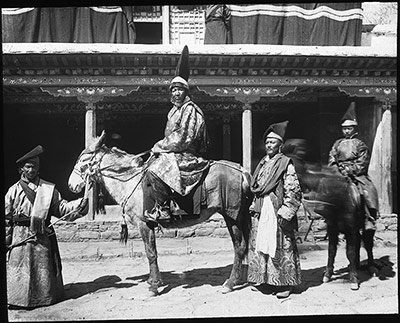
1998.285.322.2 (Lantern Slide)


1998.285.322.2 (Lantern Slide)

Rabden Lepcha?
Sir Charles Bell
March 1921
Khan Sahib Faizalla
Lhasa >
1998.285.322.2
81 x 81 mm
Riding
Lantern Slide
Donated 1983
St Antony's College, Oxford.
Sir Charles Bell's Mission to Lhasa 1920-21
Royal Central Asiatic Society
L.268
BL.H.292
Manual Catalogues - Bell's List of Illustrations entry: "[No. of chapter] LIII. [Subject of Chapter] Tribes to the West [Subject of Illustration] H.292 (b) Head of the Ladakh (Lopchak) Mission to Lhasa, and his son, both mounted. [Remark] L.268"
Other Information - Setting: Bell's Diary entry for 17th June 1921:" Khan Sahib Faizalla , the head of the Ladakhi community in Lhasa came to tea with me. He says that during the Sino-Tibetan fighting at Lhasa, ten Chinese soldiers in Trap-chi left the whole of Sera monastery at bay, and killed a great many of them. // He says the people are pleased with me now. When the question of increasing the army was agitating their minds feelings about me were varied; but now the people are easier in their minds about this." [Vol. XI, p.11]
Other Information - Cultural Background: "There are also in Lhasa some two or three hundred Mahomedans from Ladakh, the north-eastern province of Kashmir. A few of these are descendants of the prisoners captured from Zorowar Singh's army. The latter were allowed to return to Ladakh, but some, of their own accord, remained in Lhasa. These Ladakhi Mohomedans are prosperous traders; an unaggressive community that goes quietly about its business and is amenable to the Tibetan jurisdiction. It was a common sight when I was in Lhasa, to see them wending their way to a park, three miles west of the capital, where they often spent the day offering prayers, reading books and enjoying themselves in the open air. // As is the case with the Nepalese, they wear Tibetan dress, and many of them have followed the example of both Chinese and Nepalese by marrying Tibetan wives." Tibet Past & Present , Bell, C. A., Oxford: Clarendon Press, 1924, p.243
Other Information - Dates: The date of March 1921 has been given for this image as it seems to relate to 1998.285.323.1 which is detailed in Bell's List of Illustrations as having been taken in March 1921. His Diary does not mention the taking of this image, and it was most likely taken by Rabden Lepcha, probably under a separate arrangement by which Rabden would visit the mission with the express purpose of taking photographs [MS 23/02/2006]
For Citation use:
The Tibet Album.
"Head of Ladakh (Lopchak) Mission to Lhasa"
05 Dec. 2006. The Pitt Rivers Museum.
<http://tibet.prm.ox.ac.uk/photo_1998.285.322.2.html>.
For more information about photographic usage or to order prints, please visit the The Pitt Rivers Museum.
© The Pitt Rivers Museum